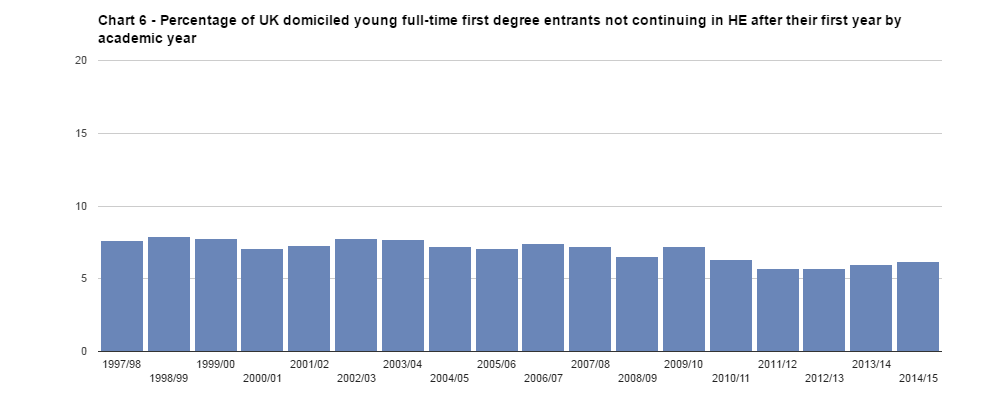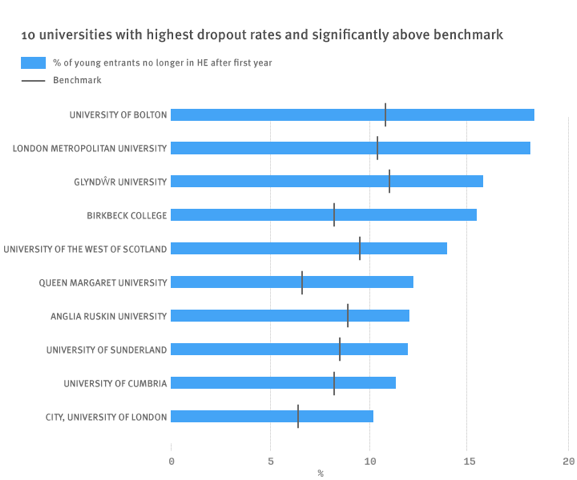The proportion of young UK students dropping out of higher education before their second year has risen for the second year in a row, latest figures have shown.
Data from the Higher Education Statistics Agency, released on 9 March, reveal that the first-year dropout rate for students aged under 21 in 2014-15 was 6.2 per cent, a slight rise on the 6 per cent figure for 2013-14.
Although the rate has come down from almost 8 per cent in the late 1990s, the fact that the indicator has crept up for a second year running may concern universities.

The rise is also reflected in separate figures showing the “projected outcomes” of young students embarking on a first degree. The proportion of students expected to leave higher education without any qualification has been creeping up in recent years and stood at 10.3 per cent in 2014-15 (although this is still well below a peak of 14.9 per cent in 2003-04).

Potentially more significant was a rise in the first-year dropout rate for young first-degree entrants from the most disadvantaged areas: this figure was 8.8 per cent in 2014-15, up from 8.2 per cent the year before and 7.7 per cent in 2012-13.
The figures could spark fears that the increase in tuition fees in England and other parts of the UK in 2012-13 may have had some influence on students’ decision about whether to stay in higher education.
Les Ebdon, director of fair access to higher education, said that it was “very disappointing” that dropout rates were on the rise again after several years of progress and that he was “particularly concerned that the non-continuation rates for young people from the most disadvantaged backgrounds have risen faster than for other groups”.
“People from disadvantaged backgrounds often overcome huge challenges to get into higher education. But access is truly meaningful only if students also complete their course. So it is crucial that universities and colleges are working across the whole student lifecycle to support all students, throughout their studies and as they prepare for work or postgraduate study.”
He said that he would expect universities to work “harder than ever to understand and address the reasons for this decline” when submitting their next access agreements, which are required to charge higher fees.
Delving into the statistics by institution shows the wide spread of dropout rates among different universities. A total of 52 providers had a first-year dropout rate of 8.1 per cent or above for young students in 2014-15; 67 had a dropout rate between 2.1 per cent and 6 per cent.

Hesa also released statistics for individual universities; dropout rates for young students vary from 18.3 per cent at the University of Bolton to 0.9 per cent at the University of Cambridge.
However, much of this difference reflects the unique mix of students that each university takes in.
More meaningful statistics can be found by comparing dropout rates with benchmarks for each institution. These reflect the average for the whole of the UK adjusted for each institution’s specific characteristics, such as location or students’ background.
Hesa identifies when an institution’s dropout rate is significantly different from its benchmark. The 10 institutions with the dropout rates that are highest and also significantly above the benchmark can be seen in the chart below.

For students from the most disadvantaged areas, the universities with dropout rates significantly above their benchmark included Bolton (dropout rate of 24 per cent, compared with a benchmark of 12.4 per cent) and Leeds Beckett University (dropout rate of 15.2 per cent, benchmark of 10.8 per cent).
Meanwhile, the Hesa data also look at dropout rates for older students and those on part-time courses, with slightly more positive results than for full-time young students.
The first-year dropout rate for older students (those aged over 21) taking a first degree was 11.7 per cent in 2014-15, down from 11.8 per cent the year before. It has continually fallen from a peak of 16 per cent in the late 1990s.

For part-time students aged 30 and under, the dropout rate for those not continuing in higher education after their second year was 37.3 per cent in 2013-14, down from 38.4 per cent the year before.
Commenting on the rise in the dropout rate for young full-time students, Paul Feldman, chief executive of Jisc, said he believed that the figures highlighted “a fundamental gap in student support services”.
“As well as widening participation challenges, we believe that one of the main causes is student mental health, with anxiety, stress and depression all linked to a fall in grades and university dropouts,” Dr Feldman said. “This is a problem that universities can’t ignore; and with the development of learning analytics technology, there is simply no excuse for universities not to spot the warning signs sooner.”
Find out more about THE DataPoints
THE DataPoints is designed with the forward-looking and growth-minded institution in view




